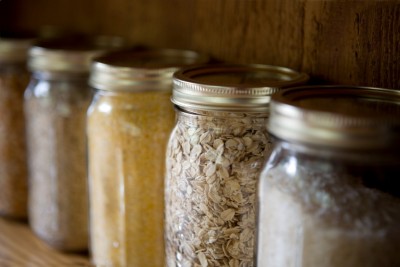 Among the many enemies to off-grid supplies is moisture. This doesn’t just affect food, although moisture can be a big problem for food. However, it is just as big a problem for a lot of different types of supplies, from medical supplies to survival equipment. Many types of materials can be damaged by moisture, especially when stored for long periods of time.
Among the many enemies to off-grid supplies is moisture. This doesn’t just affect food, although moisture can be a big problem for food. However, it is just as big a problem for a lot of different types of supplies, from medical supplies to survival equipment. Many types of materials can be damaged by moisture, especially when stored for long periods of time.
Unfortunately, the types of damage that moisture causes are not something that is readily visible from outside the container. Unless you make it a habit to regularly open up your supplies and inspect them, the first indication that you might see showing that moisture has attacked your supplies is when you open them up for use. By then, it’s too late. Rather than face that potential problem, you are better off storing your supplies in a way that protects them from moisture on a long-term basis.
Dried foods can be damaged by moisture in a number of ways. The first one to occur is that the food becomes stale. Breakfast cereals, crackers and potato chips all taste stale when they absorb moisture. While it is still possible to make them usable by removing the moisture, it is best that they stay fresh, rather than become stale.
I have tried many a time to “freshen” dry food items that have become stale. Typically, I put them on a cookie sheet and place them in the oven at the lowest possible setting. The next thing I know, I’ve left them in the oven too long and they are burned. A much better way to freshen them is to use a solar food dehydrator. The lower temperature and air movement prevent the foods from becoming burned, while still drying them out. One warning, though: Don’t put them downstream (referring to the air movement) of other foods you are drying, or they will end up absorbing moisture.
If moisture is left unchecked, it can encourage the growth of mold and mildew. These two fungi eat foodstuffs, destroying them for human consumption. Their effect is not just limited to foodstuffs however; mold and mildew can damage clothing, wood and even toilet paper. Moisture also encourages the growth of bacteria and certain types of insects, providing them with an environment where they can grow and multiply quickly.
Protecting Food And Other Supplies From Moisture
1. Airtight Containers. As you build your stockpile of supplies, everything should be packed away in airtight containers. Five gallon buckets are ideal for this, but they are not the only type of containers that you can use. Normal kitchen storage containers are usually moisture and insect proof, making them ideal for storage of smaller items.
2. Silica Gel. Many things that you buy come wrapped in plastic before being placed in the box. There will usually be a small packet inside the bag, intended to absorb moisture. This packet contains silica gel, a naturally occurring mineral that absorbs moisture. While naturally occurring, what you find in that package has been refined for use.
Are You Ready For The Coming Food Riots?
Since silica gel absorbs moisture, it is ideal for protecting pretty much anything. While the gel itself is not dangerous to your health, it is often mixed with other chemicals which can be. For this reason, the packets are often labeled with warnings not to eat them.
These packets can be harvested out of containers that you receive them in and saved for reuse. They should be stored in an airtight container, such as a jar with a lid on it, to keep them fresh and moisture-free. When you are packing supplies away, you can add a silica gel packet to the container, in with the supplies that you are storing, to protect them.
You can also buy silica gel packets or just silica gel commercially. While the packets are much more convenient for working with, unless you are putting them in with food, the packet is not necessary.
The same thing can be accomplished by putting a teaspoon or two of loose silica gel in the container before sealing it, as you can accomplish by putting one or two packets in the container.
Since I live in a high moisture area, about 50 miles from the Gulf of Mexico, I have to protect my supplies from moisture. While the moisture here isn’t as high as some areas I have lived in, it is sufficiently high that things are damaged easily. I have yet to have anything damaged which has been stored with silica gel.
3. Sugar And Salt. If you don’t have silica gel available, both salt and sugar are good moisture absorbers; although not quite as good as silica gel. Putting a teaspoon or two of either one in the container can accomplish almost the same thing. But be careful that the sugar does not attract ants.
Protecting Metal From Moisture
Rust and corrosion of metals is another serious result of excessive moisture. Both rust and corrosion are oxidation processes, where the moisture acts as the catalyst to promote oxidation. While many metal tools today are made of stainless steel to prevent rusting, not all are able to be. Stainless steel, like any materials, has its limitations, preventing it from being used in some applications. It is also more expensive than regular steel, adding cost to tools and other devices made of stainless steel.
Electronics are also highly susceptible to damage from moisture. The combination of moisture and electricity causes metals to corrode much faster than they would with only one of those two ingredients. All electronic devices, therefore, need to be protected from moisture.
4. Oil. The easiest way of protecting metals from the effects of moisture is to coat them with a light coating of oil. This won’t work for electronic devices, but it is ideal for tools, weapons and many other pieces of survival equipment. Since oil and water don’t mix, the oil forms an effective barrier, effectively eliminating oxidation. While it may be necessary to clean the oil off the tool or device before use, this is much better than having to clean off rust or corrosion.
Oil can be cleaned off of metal tools and objects with mineral spirits. It can also be cleaned off with any soap product. However, if a soap product is used, be sure to dry the metal off thoroughly, so as to eliminate corrosion caused by water. When returning the metal device to storage, lightly recoat it with oil to protect it. A heavy coating of oil is not necessary.
5. Paint. While we normally think of painting things as a way of decorating them, one of the additional purposes of paint is to protect the underlying surface from moisture. Paint provides a moisture-proof barrier, which will protect whatever it is applied to, assuming the whole surface is coated.
Paint can even be applied to sharp tools, such as axes, saws, chisels and knives. When the tool is first used, the paint will come off the tool, providing a clean, sharp cutting edge. The only problem is that the paint which comes off the tool will stick to the surface that the tool is being used on. With wood, the paint will actually become embedded in the wood fibers. Nevertheless, painting survival tools is an excellent long-term way of protecting them from moisture, especially if oil could cause stains and other problems.
The best way to paint tools for moisture protection is to dip them in the paint, and then hang them to air dry. Oil-based paints should be used, as latex paints contain water, which could cause rust on the tool.
Sign up for Off The Grid News’ weekly email and stay informed about the issues important to you
 Off The Grid News Better Ideas For Off The Grid Living
Off The Grid News Better Ideas For Off The Grid Living




